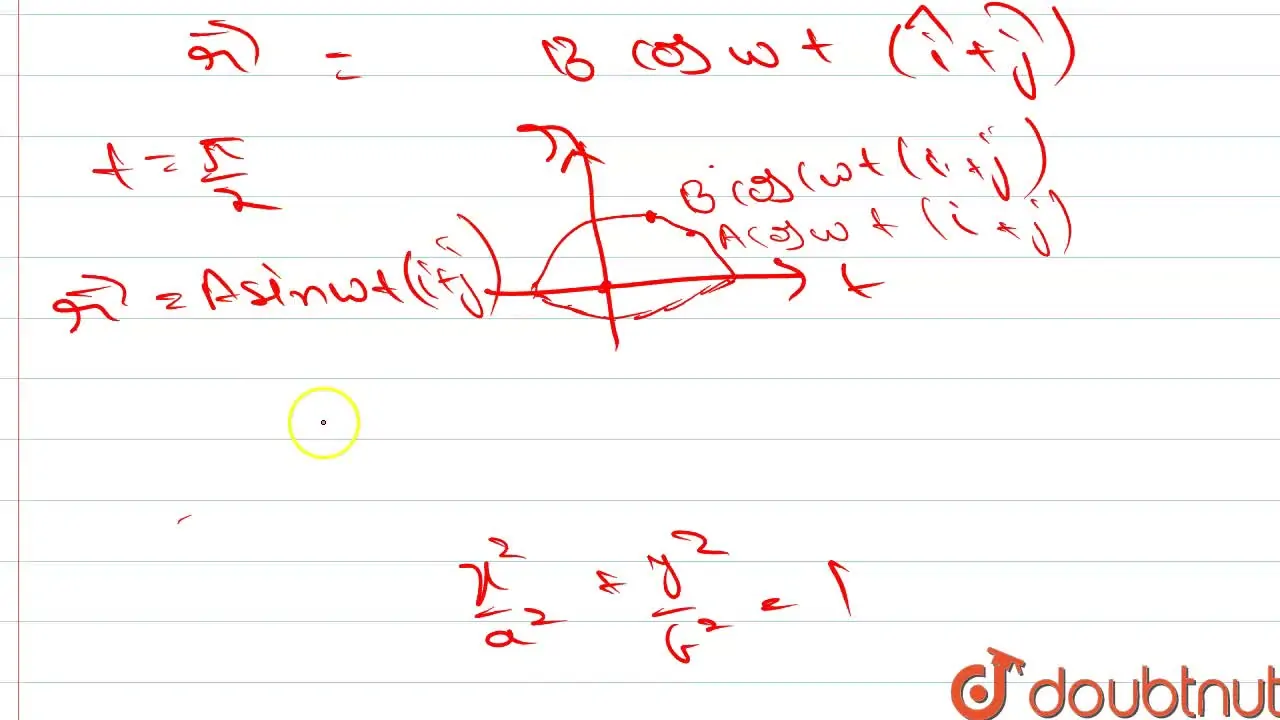A particle moves in x-y plane according to the equation →r=(Asinωt+Bcosωt)(ˆi+ˆj) :
SHM and along a straight line
SHM and along an elliptical path
SHM and along a circular path
Not SHM, but periodic
The correct Answer is:A
The given equation is rR=(Asinωt+Bcosωt)(ˆi+ˆj)
xˆj+yˆj=(Asinωt+Bcosωt)(ˆi)+(Asinωt+Bcosωt)ˆj
Comparing both sides of the above equation , we get
x=(Asinωt+Bcosωt)=√A2+B2sin(ωt+ϕ).....(i)
y=(Asinωt+Bcosωt)=√A2+B2sin(ωt+ϕ)......(ii)
From equation (i)and(ii) , we get y=x, which is the equation of a straight line . Acceleration is obtained as
a=d2rrdt2≡(d2)[(Asinωt+Bcosωt)(ˆi+ˆj)]
=−ω2[(Asinωt+Bcosωt)(ˆi+ˆj)]=−ω2rr
Thus, −√A2+B2≠y≠√A2+B2
Hence, the motion is SHM and it is along a stright path.
Related Playlists
- BOOK - VMC MODULES ENGLISHCHAPTER - SIMPLE HARMONIC MOTION EXERCISE - 6-previous year question56videos
SIMPLE HARMONIC MOTION
- BOOK - VMC MODULES ENGLISHCHAPTER - SIMPLE HARMONIC MOTION EXERCISE - 7-previous year question46videos
SIMPLE HARMONIC MOTION
- BOOK - VMC MODULES ENGLISHCHAPTER - SIMPLE HARMONIC MOTION EXERCISE - LEVEL (1)75videos
SIMPLE HARMONIC MOTION
- BOOK - VMC MODULES ENGLISHCHAPTER - ROTATIONAL MOTION EXERCISE - JEE Advanced (Archive) (True/False Type)3videos
ROTATIONAL MOTION
- BOOK - VMC MODULES ENGLISHCHAPTER - SYSTEM OF A PARTICLES & ROTATIONAL MOTIONEXERCISE - IN-CHAPTER EXERCISE F10videos
SYSTEM OF A PARTICLES & ROTATIONAL MOTION
Similar Questions
A particle moves in the x−y plane , accoding to the equation, r=(ˆi+2ˆj)Acosωt. The motion of the particle is
View SolutionThe displacement of a particle varies with time according to the relation y=asinωt+bcosωt.
View SolutionThe displacement of a particle varies with time according to the relation y=asinωt+bcoasωt.
View SolutionThe equation →r=λˆi+μˆj represents :
View SolutionA particle projected from origin moves in x-y plane with a velocity →v=3ˆi+6xˆj, where ˆi and ˆj are the unit vectors along x and y axis. Find the equation of path followed by the particle :-
View SolutionThe equation of the plane containing the line
→r=ˆi+ˆj+λ(2ˆi+ˆj+4ˆk) isView SolutionFind the vector equation of a plane containing line of intersection of plane →r⋅(2ˆi−ˆj−ˆk)=6
and plane →r⋅(3ˆi+ˆj+2ˆk)=0 and passing through (-1, 1, 2).View SolutionThe equation of the plane containing the lines →r=(ˆi+ˆj−ˆk)+λ(3ˆi−ˆj) and →r=(4ˆi−ˆk)+μ(2ˆi+3ˆk), is
View SolutionFind the vector equation of a plane passing through the intersection of the planes →r.(ˆi+ˆj+ˆk)=6 and →r.(2ˆi+3ˆj+4ˆk)−5=0 and through the point (2,2,1).
View SolutionFind the vector equation of the plane passing through the intersection of the planes →r.(ˆi+ˆj+ˆk)=6,→r.(2ˆi+3ˆj+4ˆk)=−5 and the point (1,1,1).
View Solution


